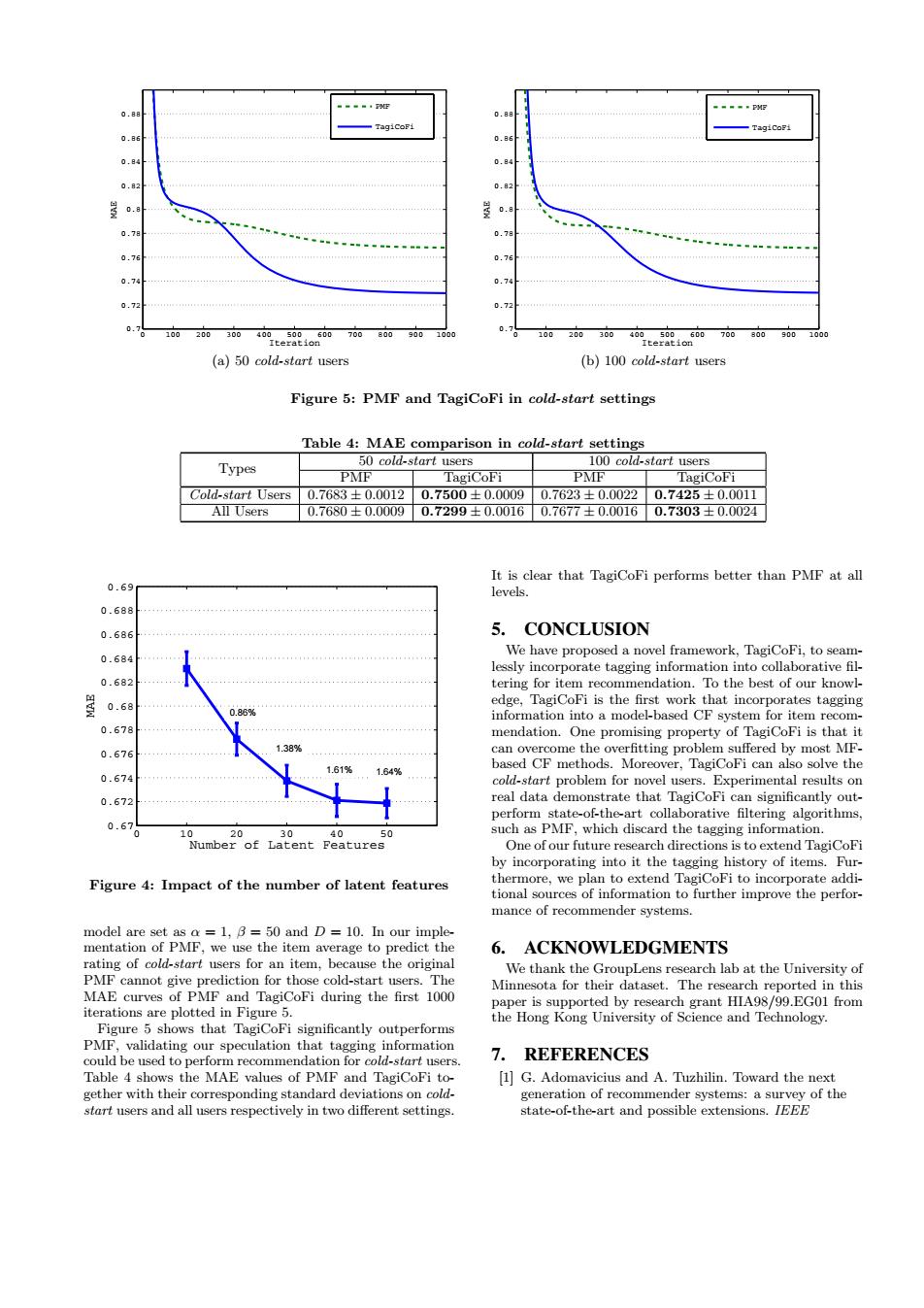正在加载图片...

0. 0.8 0.82 0. 0.78 0.76 0.74 0.72 0.72 100 0. 200300400 100 200300400 (a)50 cold-start users (b)100 cold-start users Figure 5:PMF and TagiCoFi in cold-start settings Table 4:MAE comparison in cold-start settings Types 50 cold-start users 100 cold-start users PMF TagiCoFi PMF TagiCoFi Cold-start Users0.7683±0.00120.7500±0.00090.7623±0.00220.7425±0.0011 All Users 0.7680±0.00090.7299±0.00160.7677±0.00160.7303±0.0024 It is clear that TagiCoFi performs better than PMF at all 0.69 levels. 0.688 0.686 5.CONCLUSION 0.684 We have proposed a novel framework,TagiCoFi,to seam- lessly incorporate tagging information into collaborative fil- 0.682 tering for item recommendation.To the best of our knowl- 0.68 edge,TagiCoFi is the first work that incorporates tagging information into a model-based CF system for item recom- 0.678 mendation.One promising property of TagiCoFi is that it 1.389% 0.676 can overcome the overfitting problem suffered by most MF- 1.61% based CF methods.Moreover,TagiCoFi can also solve the 0.674 cold-start problem for novel users.Experimental results on 0.672………-… real data demonstrate that TagiCoFi can significantly out- perform state-of-the-art collaborative filtering algorithms, 0.67 0 1 20 30 40 0 such as PMF,which discard the tagging information. Number of Latent Features One of our future research directions is to extend TagiCoFi by incorporating into it the tagging history of items.Fur- Figure 4:Impact of the number of latent features thermore,we plan to extend TagiCoFi to incorporate addi- tional sources of information to further improve the perfor- mance of recommender systems. model are set as a =1.B=50 and D=10.In our imple- mentation of PMF,we use the item average to predict the 6. ACKNOWLEDGMENTS rating of cold-start users for an item,because the original We thank the GroupLens research lab at the University of PMF cannot give prediction for those cold-start users.The Minnesota for their dataset.The research reported in this MAE curves of PMF and TagiCoFi during the first 1000 paper is supported by research grant HIA98/99.EG01 from iterations are plotted in Figure 5. the Hong Kong University of Science and Technology. Figure 5 shows that TagiCoFi significantly outperforms PMF,validating our speculation that tagging information could be used to perform recommendation for cold-start users. 7. REFERENCES Table 4 shows the MAE values of PMF and TagiCoFi to- [1]G.Adomavicius and A.Tuzhilin.Toward the next gether with their corresponding standard deviations on cold- generation of recommender systems:a survey of the start users and all users respectively in two different settings. state-of-the-art and possible extensions.IEEE0 100 200 300 400 500 600 700 800 900 1000 0.7 0.72 0.74 0.76 0.78 0.8 0.82 0.84 0.86 0.88 Iteration MAE PMF TagiCoFi (a) 50 cold-start users 0 100 200 300 400 500 600 700 800 900 1000 0.7 0.72 0.74 0.76 0.78 0.8 0.82 0.84 0.86 0.88 Iteration MAE PMF TagiCoFi (b) 100 cold-start users Figure 5: PMF and TagiCoFi in cold-start settings Table 4: MAE comparison in cold-start settings Types 50 cold-start users 100 cold-start users PMF TagiCoFi PMF TagiCoFi Cold-start Users 0.7683 ± 0.0012 0.7500 ± 0.0009 0.7623 ± 0.0022 0.7425 ± 0.0011 All Users 0.7680 ± 0.0009 0.7299 ± 0.0016 0.7677 ± 0.0016 0.7303 ± 0.0024 0 10 20 30 40 50 0.67 0.672 0.674 0.676 0.678 0.68 0.682 0.684 0.686 0.688 0.69 Number of Latent Features MAE 0.86% 1.38% 1.61% 1.64% Figure 4: Impact of the number of latent features model are set as α = 1, β = 50 and D = 10. In our implementation of PMF, we use the item average to predict the rating of cold-start users for an item, because the original PMF cannot give prediction for those cold-start users. The MAE curves of PMF and TagiCoFi during the first 1000 iterations are plotted in Figure 5. Figure 5 shows that TagiCoFi significantly outperforms PMF, validating our speculation that tagging information could be used to perform recommendation for cold-start users. Table 4 shows the MAE values of PMF and TagiCoFi together with their corresponding standard deviations on coldstart users and all users respectively in two different settings. It is clear that TagiCoFi performs better than PMF at all levels. 5. CONCLUSION We have proposed a novel framework, TagiCoFi, to seamlessly incorporate tagging information into collaborative filtering for item recommendation. To the best of our knowledge, TagiCoFi is the first work that incorporates tagging information into a model-based CF system for item recommendation. One promising property of TagiCoFi is that it can overcome the overfitting problem suffered by most MFbased CF methods. Moreover, TagiCoFi can also solve the cold-start problem for novel users. Experimental results on real data demonstrate that TagiCoFi can significantly outperform state-of-the-art collaborative filtering algorithms, such as PMF, which discard the tagging information. One of our future research directions is to extend TagiCoFi by incorporating into it the tagging history of items. Furthermore, we plan to extend TagiCoFi to incorporate additional sources of information to further improve the performance of recommender systems. 6. ACKNOWLEDGMENTS We thank the GroupLens research lab at the University of Minnesota for their dataset. The research reported in this paper is supported by research grant HIA98/99.EG01 from the Hong Kong University of Science and Technology. 7. REFERENCES [1] G. Adomavicius and A. Tuzhilin. Toward the next generation of recommender systems: a survey of the state-of-the-art and possible extensions. IEEE